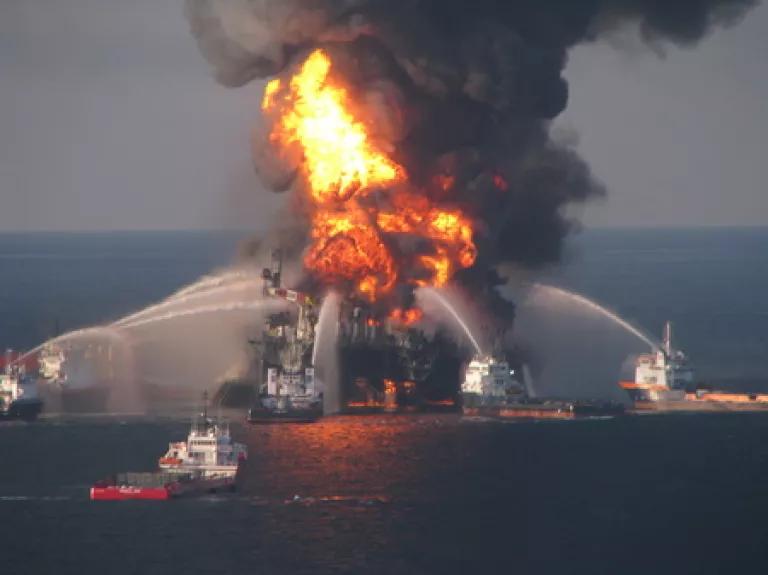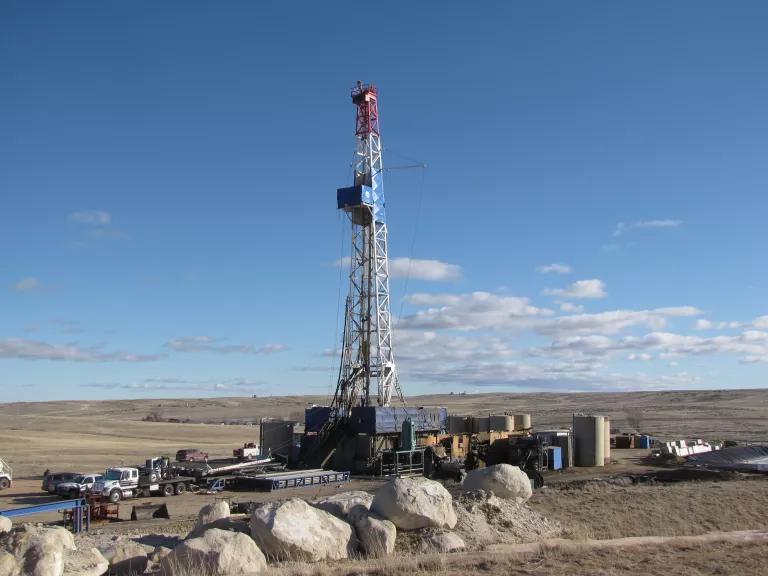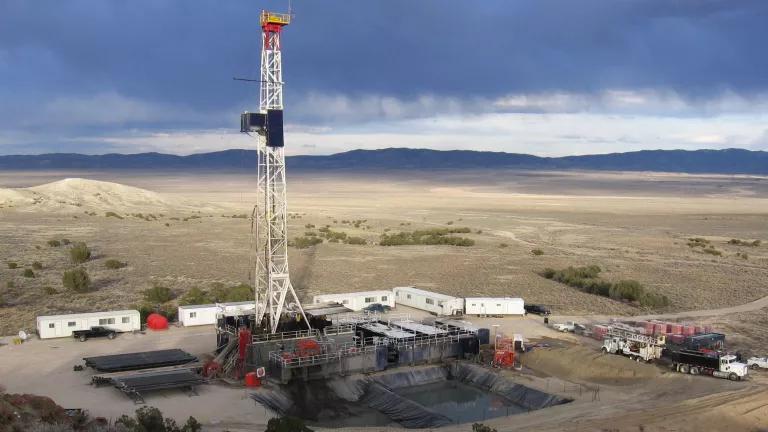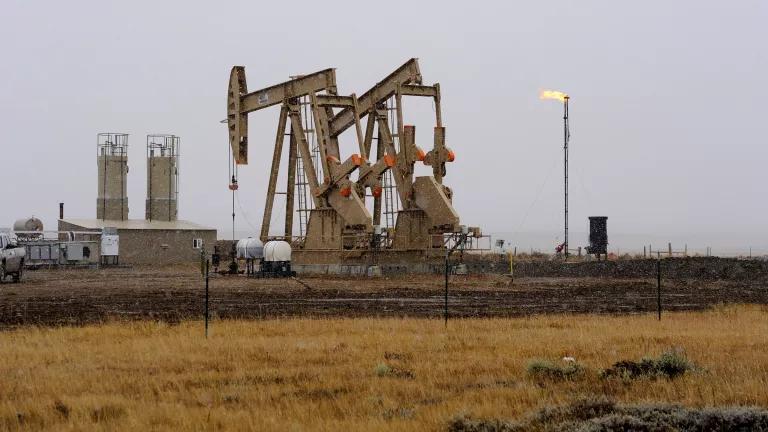Federal Oil and Gas Leasing Needs Reform and Phaseout
As climate change inflicts mounting costs and rising dangers on people across the country, selling off our public lands and waters to fossil fuel companies at steep discounts serves neither present nor future generations. Instead, it locks both into the very fuels that are driving the climate crisis.

Offshore oil rig by C. Morrison
When the Department of Interior convenes its forum on the future of its oil and gas leasing programs on Thursday, it must recall its presiding mission to manage our public resources for the benefit of present and future generations. As climate change inflicts mounting costs and rising dangers on people across the country, selling off our public lands and waters to fossil fuel companies at steep discounts serves neither present nor future generations. Instead, it locks both into the very fuels that are driving the climate crisis.
Public lands and waters must become part of the climate solution—not a continuing part of the problem.
When the System Is Broken, It’s Time to Fix It
The Biden administration’s executive order on January 27, 2021 put a pause on all new oil and gas leasing on public lands and waters while the administration reviews the federal leasing programs and decides how to reform its policies for the future.
This pause was a long time coming.
For at least a decade, government watchdogs have flagged significant concerns with the federal leasing program: Not enough money being collected to clean up old wells, companies paying bargain basement prices to access and profit from public resources, and the agencies tasked with ensuring compliance with regulations lacking the resources for proper enforcement.
Now, the Department of Interior has a once-in-a-generation opportunity to tackle an issue that will prove critical to this country’s ability to meet its climate goals and mitigate the worst impact of climate change. Doing so will require forward-looking, science-based decision-making, deep and meaningful engagement with stakeholders, and a recognition that our public lands and waters are meant to benefit the many and not the few fossil fuel corporations sitting on tens of millions of acres of lands and oceans.
Offshore Drilling Is a Bum Deal for Oceans and Climate
Offshore drilling threatens our ocean, coastal communities, and future. Between the devastating long-term damage of oil spills and a world that is already reeling from the impacts of climate change, there is no scenario where it makes sense to continue our reliance on fossil fuels and drill off our coasts.
The ocean sustains life both in water and on land. It is home to marine life, provides food to millions of people, and supports coastal economies that depend on clean and healthy waters and beaches. Expanding offshore drilling would threaten our coastal economies, millions of people, and marine ecosystems alike, which are already dealing with climate change impacts: the ocean has absorbed 90% of the excess heat put into the atmosphere by burning fossil fuels.
A hotter ocean is fueling destructive hurricanes, increased wildfires, flooding, deadly heat waves and more—the last thing coastal communities need is an oil spill to contend with. Rather than continue along the status quo or expanding oil and gas production offshore, it is crucial that we end our reliance on fossil fuels as soon as possible. As we do that, we must ensure a just transition for workers and local communities and the best practicable remediation of the industry’s environmental damages.
Largely due to these risks, offshore drilling is not popular with anyone beyond the fossil fuel industry—there is widespread bipartisan opposition because of the threat that offshore drilling poses to the marine environment and coastal economies. People are tired of the dirty and dangerous fossil fuel industry that has a terrible record of cleaning up after their messes.

The Biden Administration should cancel the remaining offshore lease sales in the current program, scrap the draft Trump program, and start a new five-year program process
We cannot afford to burn the fossil fuels that we already have, let alone drill for new reserves. Offshore drilling is basically a double blow to our oceans—increasing the risk of spills and pollution in the marine environment while fueling climate change impacts. It is time to end new leasing in the outer continental shelf.
If the administration is serious about climate, it should first cancel the four remaining lease sales in the current program (three in the Gulf, one in Cook Inlet in Alaska) that goes through 2022. The industry has been stockpiling leases in federal waters—and is not using 77% of those leases. The oil and gas industry does not need any more offshore lease sales.
The administration should also scrap Trump’s draft five-year program and start a new planning process. This new five-year program should incorporate the best available science on climate change – and science will undoubtedly show that we do not need, and cannot afford, more offshore drilling. A Biden five-year program should adopt a null schedule with no new leasing in federal waters.
It isn’t just offshore drilling either—seismic testing is both the gateway to offshore oil and gas development and a major stressor on marine species from invertebrates to whales. Consistent with the principle of no new leasing, the Administration should issue no permits for new oil and gas seismic testing but merely for the development of existing leases.
The oil and gas industry is using scare tactics. It is trying to paint this federal leasing pause as an existential threat. Nearly the opposite is true: continuing this broken system of leasing poses a clear existential threat to all of us. The industry’s own projections show that existing leases could provide significant continuing supply for decades, providing ample time for a transition to rapidly growing clean energy sources.
Onshore Oil and Gas Leasing Is Off the Rails
Nothing illustrates how broken federal leasing of public lands is than the story of a Burmese perfume entrepreneur who, over the course of five months at the end of 2020, purchased 25 percent of the public lands offered for lease for oil and gas drilling. Despite assuring the Bureau of Land Management that she intended to develop the leases, recent investigations reveal her real intentions: flip the real estate to turn a quick profit on lands with almost no potential for ever producing a drop of oil or a puff of gas.
It sounds like the stuff of television drama. It sounds illegal. Instead, it encapsulates the no-holds-barred approach, enabled by a suite of out-of-date regulations and policies, of the Trump administration’s treatment of public lands as a goody basket for the fossil fuel interests whose lobbyists populated many of the top spots in key agencies during Trump’s tenure.
In the aftermath of this free for all, 26 million acres of public lands are now locked up by oil and gas leases, with 80 percent of those acres in the West. A lot of it is not acreage industry appears to have much need for: it is only drilling on about half of those acres, and the bulk of annual production in this country comes from drilling on state and private lands.

Directional drilling rig in Wyoming
The System Needs Reform and Phaseout
As industry leaders have themselves admitted, a pause on federal oil and gas leasing will have a limited effect on current operations. Recent analysis of existing leases and drilling permits confirms this reality—industry's lease stockpile could last it a decade, allowing production to continue without any new leasing.
In the meantime, a leasing pause gives the Bureau of Land Management time to focus on the long list of necessary reforms that will protect public lands, reduce climate pollution, enhance taxpayer returns, and protect communities from the widespread harms of oil and gas drilling on public lands. A focus on reform also creates the space for the Bureau to think longer term, consistent with its legal mandate to manage for the future, about the ways it can equitably manage the necessary end of oil and gas drilling on these lands.
This approach will benefit taxpayers and frontline communities. Prohibitions on speculative leasing will stop public lands with no potential for producing oil and gas from being locked up by industry with almost no financial benefit to taxpayers. Enhanced methane waste regulations will curtail out-of-control emissions of this potent greenhouse gas. Significant increases in bonding requirements will encourage companies to plug old and abandoned wells and reduce the burden on taxpayers created by the current abandoned well epidemic that exists on public and private lands across the country. Modern royalty rates will increase taxpayer returns from existing drilling by aligning rates with those imposed for offshore drilling and those required by many states on state lands.
In the second phase of reform, the Bureau of Land Management must face the writing on the wall. Climate change is accelerating and there is little time to hold the worst outcomes at bay. If the U.S. stays even remotely close to honoring its commitments under the Paris Agreement and truly acts according to the best available science, demand for oil and gas in this country is at its peak and will begin a swift and permanent decline. Forthcoming modeling by NRDC shows just how dramatic a change this will bring for oil and gas drillers in this country, with projected production expected to significantly outstrip demand in less than a decade.

Projected U.S. Oil Demand in Climate Safe Scenario
The declining demand and ensuing supply glut align remarkably well with the existing federal lease stockpile held by oil and gas drillers. This is an opportunity for the Bureau and other branches of government to avoid past mistakes. It’s a chance to ensure that fossil-dependent communities and workforces are prepared for the accelerating energy transition long before their jobs disappear. There are lots of policy options championed in Congress and elsewhere–from workforce training to community development grants to job programs focused on industry cleanup and enhanced conservation.
In other words, outside of the industry bubble where leaders and lobbyists are warning the sky is falling, there’s already work underway to make sure that as oil and gas jobs continue their decades-long decline, we can avoid as many economic hardships as possible. This requires open mindedness and a willingness to accept and embrace change—but it doesn’t mean compromising quality of life or economic security.
No Time Like the Present to Save Nature and Save Ourselves
As the Department of Interior formally begins its wholesale review of various oil and gas leasing programs, it can make a major step toward a climate-safe future. Right now, 25 percent of the country’s greenhouse gas emissions each year come from the fossil fuel production taking place on our public lands and waters. The agencies tasked with managing these areas have a tremendous opportunity to rapidly ramp down U.S. climate pollution. This is a complex management puzzle, and as its pieces are assembled, the Department needs to move forward swiftly with its near-term priorities for common-sense reforms to reduce pollution, improve taxpayer benefits, and begin to manage our federal lands and waters to help solve—not worsen—the climate crisis.






